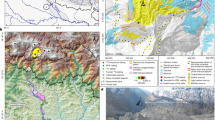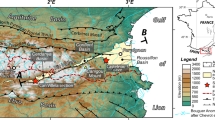Abstract
THE hypothesis1 that late Cenozoic uplift of many of the world's mountain ranges was a response to climate change rather than to tectonic processes is based on the premise that enhanced erosion in an altered climate led to a reduction in both the total mass of a mountain range and its mean elevation. This reduction was coeval with increased regional relief and with passive isostatic uplift of the remaining summits. The hypothesis is difficult to evaluate because both climate and tectonic forces affect uplift in many active ranges. In the absence of sufficient denudational and uplift data from the mountains themselves, depositional patterns in adjacent basins may sometimes be used to distinguish between uplift arising from erosional or from tectonic processes. In foreland basins, uplift of the proximal basin and a reduction or absence of asymmetric subsidence are predicted responses to erosionally driven uplift2. Here I show that patterns of sediment accumulation and the position of major rivers in the Neogene Gangetic foreland basin seem to have changed markedly in Plio-Pleistocene times. These changes lend support to the hypothesis that the importance of erosional unloading has increased in the Himalayas during the past 4 Myr.
This is a preview of subscription content, access via your institution
Access options
Subscribe to this journal
Receive 51 print issues and online access
$199.00 per year
only $3.90 per issue
Buy this article
- Purchase on Springer Link
- Instant access to full article PDF
Prices may be subject to local taxes which are calculated during checkout
Similar content being viewed by others
References
Molnar, P. & England, P. Nature 346, 29–34 (1990).
Heller, P. L., Angevine, C. L., Winslow, N. S. & Paola, C. Geology 16, 501–504 (1988).
Sibrava, V., Bowen, D. Q. & Richmond, G. M. Quaternary Glaciations in the Northern Hemisphere (Quat. Sci. Rev. 5) (1986).
Flemings, P. B. & Jordan, T. E. J. geophys. Res. 94, 3851–3866 (1989).
Flemings, P. B. & Jordan, T. E. Geology 18, 430–434 (1990).
Angevine, C. L., Heller, P. L. & Paola, C. Quantitative Sedimentary Basin Modelling (American Association of Petroleum Geologists, Tulsa, 1990).
Burbank, D. W. & Beck, R. A. Geol. Rund. 80 (1991).
Naini, B. P. thesis, Columbia Univ. (1980).
Curray, J. R. Geology 19, 1097–1100 (1991).
Molnar, P. A. Rev. Earth planet Sci. 12, 489–518 (1984).
Ahnert, F. Am. J. Sci. 268, (1970).
Raiverman, V., Kunte, S. V. & Mukherjea, A. Petrol. Asia J. 67–92 (1983).
Raynolds, R. G. H. thesis, Dartmouth College (1980).
Tandon, S. K. & Rangaraj, S. in Structural Geology of the Himalaya (ed. Saklani, P. S.) (Today and Tomorrow's Printers and Publishers, Delhi, 1979).
Burbank, D. W. & Beck, R. A. Geol. Bull. Univ. Peshawar 22, 11–24 (1989).
Burbank, D. W., Beck, R. A. & Talling, P. J. Geol. Soc. Am. Abst. Prog. 23, 241 (1991).
Johnson, N. M., Stix, J., Tauxe, L., Cerveny, P. F. & Tahirkheli, R. A. K. J. Geol. 93, 27–40 (1985).
Molnar, P., Burchfiel, B. C., K'uangyi, L. & Zhao, Z. Geology 15, 249–253 (1987).
Molnar, P. et al. Geol. Soc. Am. Abstr. Prog. 23, 373 (1991).
Burchfiel, B. C. et al. Tectonics 10, 1091–1110 (1991).
Zhang, P. et al. Tectonics 10, 1111–1129 (1991).
Burbank, D. W. & Raynolds, R. G. H. in New Perspectives in Basin Analysis (ed. Kleinspehn, K. L. & Paola, C.) (Springer, New York, 1988).
Karunakaran, C. & Rao, A. R. Geol. Sur. India Misc. Publ. 41, 1–66 (1979).
Burbank, D. W. & Beck, R. A. Geology 19, 1169–1172 (1991).
Adhikari, K. et al. Eos Trans. 72, 496 (1991).
Liu, T. Aspects of Loess Research (China Ocean, Beijing, 1987).
Burbank, D. W., Beck, R. A., Raynolds, R. G. H., Hobbs, R., Takirkheli, R. A. K. Geology 16, 1143–1146 (1988).
Raynolds, R. G. H. & Johnson, G. D. in The Chronology of the Geologic Record (ed. Snelling, N. J.) (Geological Society of London, 1985).
Acharyya, S. K. & Ray, K. K. AAPG Bulletin 66, 57–70 (1982).
Harrison, T. M., Copeland, P., Kidd, W. S. F. & Yin, A. Science 255, 1663–1670 (1992).
Prell, W. L. & Kutzbach, J. E. Eos 72, 257–258 (1991).
Shackleton, N. J. et al. Nature 307, 620–623 (1984).
Author information
Authors and Affiliations
Rights and permissions
About this article
Cite this article
Burbank, D. Causes of recent Himalayan uplift deduced from deposited patterns in the Ganges basin. Nature 357, 680–683 (1992). https://doi.org/10.1038/357680a0
Received:
Accepted:
Issue Date:
DOI: https://doi.org/10.1038/357680a0
This article is cited by
-
Tectonic uplift of the Tianshan Mountains since Quaternary: evidence from magnetostratigraphy of the Yili Basin, northwestern China
International Journal of Earth Sciences (2023)
-
Neotectonic and climatic control on channel evolution in the Himalayan foot-hill, northern West Bengal, India – A case study
Journal of Earth System Science (2022)
-
Hydrogeochemical processes and groundwater quality of over-exploited Dupi Tila aquifer in Dhaka city, Bangladesh
Environmental Science and Pollution Research (2022)
-
Sedimentary facies analysis of the fluvial environment in the Siwalik Group of eastern Nepal: deciphering its relation to contemporary Himalayan tectonics, climate and sea-level change
Progress in Earth and Planetary Science (2021)
-
Geomorphological responses of rivers to active tectonics along the Siwalik Hills, Midwestern Nepalese Himalaya
Journal of Mountain Science (2021)
Comments
By submitting a comment you agree to abide by our Terms and Community Guidelines. If you find something abusive or that does not comply with our terms or guidelines please flag it as inappropriate.



